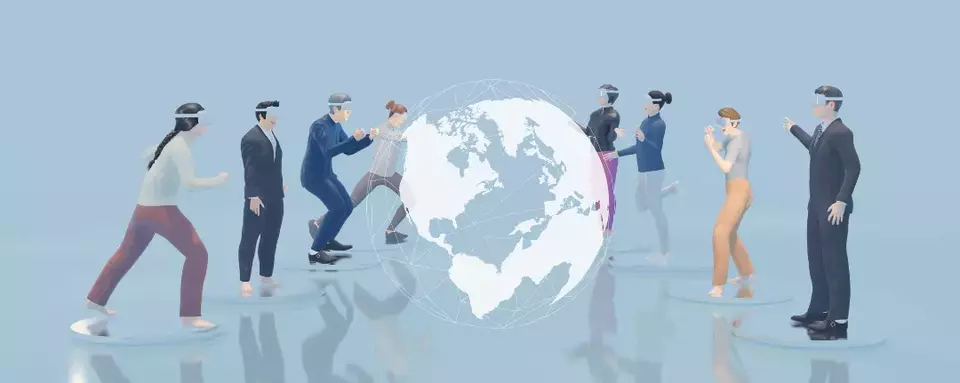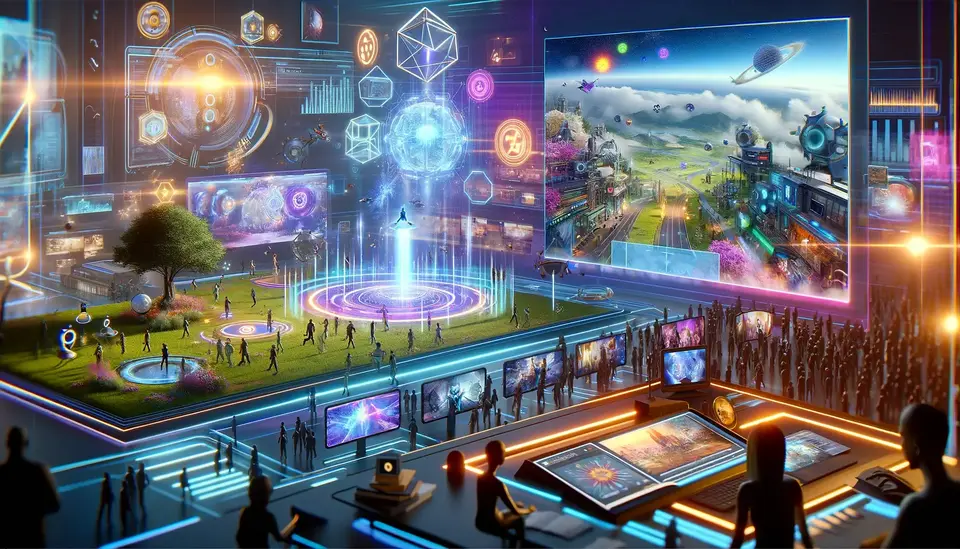Disadvantages of Metaverse
Posted on September 18, 2023 21 minutes 4470 words
Table of contents
1. Introduction
In recent years, a term that has increasingly reverberated in the echelons of technology and digital culture is “Metaverse”. Often hailed as the next phase in the evolution of the internet, the Metaverse is essentially a virtual reality space where users can interact with a computer-generated environment and other users in real-time. It seeks to amalgamate various aspects of our daily lives into a cohesive, digital, and sometimes, three-dimensional sphere, encompassing elements of social media, online gaming, augmented reality (AR), virtual reality (VR), 3D technology, and more. Through these immersive experiences, individuals can work, socialize, create, and even engage in economic transactions.
In this technological zeitgeist, where the boundaries between the physical and digital worlds are becoming increasingly porous, the Metaverse is positioning itself as a significant player. Companies, big and small, are investing heavily in this virtual frontier, envisaging a future where the Metaverse is as commonplace as the internet is today. Its growing prevalence is reflected in burgeoning virtual real estates, proliferating virtual goods and commodities, and an expanding array of platforms offering immersive experiences that extend beyond the screens and into wearable technologies and augmented realities.
While the metamorphosis from the internet to the Metaverse holds an undeniable allure, festooned with promises of innovation and a revolutionary shift in how we perceive and interact with the digital realm, it is incumbent upon us to critically examine this transition. As we stand at the cusp of possibly ushering in a new digital era, an analysis that extends beyond the allure of a technologically advanced utopia is imperative. This not only encompasses probing the untapped potentials but also necessitates a deep dive into the possible repercussions and downsides of a world increasingly enmeshed in the Metaverse.
The increasing influence of the Metaverse on various sectors including education, employment, and entertainment demands an exploration of the potential pitfalls and challenges that might accompany its rise. As we forge ahead into this uncharted territory, questions about data privacy, digital divide, social isolation, and a myriad of other concerns loom large. It is essential to navigate these waters with a nuanced understanding, allowing us to foster a digital environment that is inclusive, safe, and beneficial for all.
In this article, we delve deep into the potential disadvantages of the Metaverse, examining its impact from technological, economic, sociocultural, and psychological perspectives. Through a critical lens, we aim to shed light on the potential dark corners of the Metaverse, urging stakeholders and users alike to approach this digital frontier with caution and awareness. It is with a hope that this analysis will serve as a catalyst for informed discussions and decisions in the shaping of a Metaverse that holds true to the ideals of fostering positive advancements while mitigating potential downsides.
2. Technological Challenges
As the Metaverse expands its horizons, engulfing more of our daily interactions and activities, the technological challenges it ushers in cannot be understated. The realms of cybersecurity and technological equality are particularly crucial areas where the potential downsides seem to be escalating at a pace parallel to advancements. Below, we dissect these challenges in more depth, focusing on cybersecurity concerns and the growing technological inequalities that are becoming increasingly evident.
2.1 Cybersecurity Concerns
Increased Risks of Hacking, Phishing, and Scams
As the borders between the real and virtual worlds blur, the Metaverse may inadvertently become a fertile ground for cybercriminals. A surge in the avenues for interaction and transaction means a proportional increase in vulnerabilities that can be exploited. Complex hacking attempts could become more frequent, targeting not only individuals but also organizations and virtual economies that are integral components of the Metaverse.
In this interconnected virtual environment, scams and phishing attempts might become more sophisticated, leveraging artificial intelligence and deep learning to deceive users with remarkable realism. This may manifest in the creation of fraudulent virtual entities, assets, and environments designed to lure users into traps, ultimately compromising their virtual and real-world assets and identities. The repercussions can range from financial losses to the theft of sensitive personal data, creating a persistent climate of mistrust and insecurity.
Data Privacy and Potential Misuse of Personal Information
In the Metaverse, personal data takes on a new dimension. As users engage in a myriad of activities, from social interactions to economic transactions, the data trails they leave are potentially vast and intricate. This exacerbates the existing concerns about data privacy, as it provides fertile ground for the misuse of personal information.
Companies might employ advanced tracking techniques to monitor user behavior in unprecedented detail, harvesting data for targeted advertising and other commercial exploits. Furthermore, the centralized nature of many Metaverse platforms raises the specter of mass data collection, where a handful of entities have control over a significant proportion of user data. This not only places enormous power in the hands of a few but also presents an enticing target for cybercriminals aiming to harvest data on a large scale. The users, in turn, are left grappling with the potential misuse of their personal information, identity theft, and other forms of cyber exploitation, undermining the fundamental right to privacy and data protection.
2.2 Technological Inequalities
Digital Divide and Accessibility Issues
The rise of the Metaverse is set against the backdrop of a world still grappling with significant digital divides. These divides are not just about access to internet connectivity, but also encompass disparities in the availability of advanced technologies necessary to fully participate in the Metaverse.
In various regions around the globe, a sizable portion of the population lacks basic internet access, let alone the high-speed connectivity required for a seamless Metaverse experience. This has the potential to exacerbate existing inequalities, as individuals in these regions are sidelined from the opportunities and advancements that the Metaverse brings.
Moreover, the Metaverse might heighten accessibility issues, with certain groups, including the elderly and individuals with disabilities, finding it challenging to navigate the complex, high-tech environments. This raises concerns about the potential for digital exclusion, where a segment of the population is left behind in the race to embrace the virtual frontier.
The Need for High-Speed Internet and Advanced Technology
For a fully immersive and responsive Metaverse experience, the prerequisites are high-speed internet connectivity and advanced technology, encompassing powerful computing devices and potentially augmented reality (AR) and virtual reality (VR) equipment. These technologies come with substantial costs, creating a barrier to entry for individuals and communities with limited resources.
Furthermore, these advancements might foster a form of technological elitism, where only those who can afford the latest technologies can fully participate in the Metaverse, enjoying the highest quality experiences and opportunities. This bifurcation can lead to a stratified Metaverse society, mirroring and potentially intensifying the socio-economic disparities observed in the real world.
As we venture further into the Metaverse era, it is essential that we address these technological inequalities head-on, fostering inclusivity and equal opportunity as core principles in the development and governance of virtual spaces. It calls for concerted efforts from stakeholders, including governments, to bridge the digital divide and ensure that the Metaverse does not become a playground for the privileged few, but a space of equal opportunity for all.
3. Economic Issues
As the Metaverse blossoms, it brings to the fore significant economic challenges that encompass issues of monopoly, centralization, and job displacement. These facets are critical, given their potential to drastically reshape the global economic landscape. This section explores the economic aspects that are intertwined with the unfolding tapestry of the Metaverse, examining the ramifications that may emanate from unchecked market monopolization, centralization, and shifts in job markets.
3.1 Monopoly and Centralization
Possibility of Market Monopolization by a Few Companies
One of the pressing concerns in the evolving narrative of the Metaverse is the looming threat of market monopolization by a handful of mega-corporations. This concern is not unfounded, as the digital space has historically been characterized by oligopolies, where a small number of companies control a substantial market share. The Metaverse, being an amalgamation of various digital platforms and services, provides a fertile ground for companies with substantial capital and resources to dominate.
These entities might leverage their influence to stifle competition, potentially hindering innovation and creating a market environment where they dictate terms and conditions to a significant extent. This could result in a less diverse Metaverse, bereft of the vibrant competition that drives innovation and improvement. Moreover, users might find themselves confined to platforms that prioritize profit over user experience, leading to exploitative practices and reduced freedom of choice.
Centralization of Data and the Potential for Misuse
As the Metaverse expands, so does the volume of data generated within its realms. This surge in data acquisition raises the specter of centralization, where a few entities possess the majority of user data, accruing an unprecedented level of influence and power.
This centralization of data control not only paves the way for potential misuse but also creates a single point of failure, making the Metaverse susceptible to large-scale data breaches and cyber-attacks. The centralized entities could potentially manipulate data to shape user perceptions and behaviors, skewing the virtual marketplace and even influencing real-world dynamics. Furthermore, the commodification of user data might intensify, with corporations using intricate data profiles to target users with personalized advertising, often at the expense of user privacy and autonomy.
3.2 Job Displacement
The Potential for Job Losses Due to Automation and Virtual Economies
The onset of the Metaverse heralds a shift in the economic fabric, with automation and virtual economies becoming more prominent. This shift, while harboring potential for innovation and growth, also threatens to displace traditional jobs.
Automation, an intrinsic component of the Metaverse, might lead to a significant reduction in the need for human labor in various sectors. Jobs, particularly those that are repetitive and manual, might find themselves rendered obsolete, as virtual environments and AI-driven systems take over.
Similarly, the rise of virtual economies might create a dichotomy where virtual jobs overshadow real-world occupations. While this could spawn new avenues of employment, the transition might not be smooth, leading to potential job losses and economic disruptions.
The Evolving Nature of Work and Potential Inequalities
As the Metaverse reshapes the contours of employment, it brings forth an evolving nature of work, characterized by a blend of virtual and real-world tasks. This evolution, however, might foster inequalities, as individuals with skills pertinent to the Metaverse thrive, while others find themselves at a disadvantage.
The demand for digital literacy and proficiency in navigating virtual spaces might create a rift, separating those who can adapt from those who cannot. Moreover, the potential for gig economy models to dominate the Metaverse labor market might lead to precarious employment conditions, characterized by lack of job security, inadequate wages, and diminished workers’ rights.
As we navigate this transformative phase, it is imperative to foster an inclusive economic landscape, where opportunities are not confined to a privileged few, but are accessible to all, irrespective of their background or skill set. This necessitates proactive measures to facilitate skill development and education, ensuring that the workforce is equipped to thrive in the evolving Metaverse economy. Moreover, it calls for regulatory frameworks that prevent market monopolization and data centralization, safeguarding the economic wellbeing and privacy of users in the Metaverse.

4. Sociocultural Concerns
The development and expansion of the Metaverse not only bring forth economic and technological challenges but also potentially reshape our sociocultural landscape in profound ways. The lines between the virtual and real worlds might blur, leading to new kinds of experiences that can have both enriching and detrimental effects on individuals and societies at large. In this section, we explore the possible sociocultural concerns that might arise, focusing particularly on the issues of social isolation and the blending of reality and virtuality, often referred to as ‘reality blur’.
4.1 Social Isolation
Reduced Physical Interactions and Potential Increase in Social Isolation
While the Metaverse promises to bring individuals closer through virtual mediums, it may paradoxically foster a kind of isolation where physical interactions become reduced. As users immerse themselves in virtual realms, the need or desire for face-to-face interactions may diminish. This is concerning as physical interactions form the bedrock of human socialization, facilitating nuanced communication, emotional bonds, and a sense of community that virtual interactions might not fully replicate.
Furthermore, the virtual space can potentially become a solitary experience, where users engage with scripted environments and AI-controlled characters rather than real people. This shift can subtly foster social isolation, as individuals find themselves spending increasing amounts of time in isolation, disconnected from the communal experiences that enrich our social fabric.
Impacts on Mental Health and Well-being
The potential increase in social isolation is not merely a sociocultural concern but a health concern as well. Social isolation can have serious repercussions on individuals’ mental health and well-being. The lack of physical interaction can potentially lead to feelings of loneliness, depression, and anxiety, as individuals grapple with a life that is increasingly devoid of real human contact.
Furthermore, the Metaverse can potentially foster addictive behaviors, as users become increasingly engrossed in virtual worlds, neglecting their physical health and well-being. There is also the risk of users developing a distorted perception of social norms and behaviors, as the virtual environments might not accurately reflect the complexities and nuances of real-world social interactions. This dissonance can potentially exacerbate mental health issues, as individuals find it challenging to navigate the disparities between the virtual and real worlds.
4.2 Reality Blur
Difficulties Distinguishing Between Virtual and Real Worlds
As the Metaverse becomes more immersive and complex, the boundaries between the virtual and real worlds may become increasingly blurred. Users might find it challenging to differentiate between experiences and interactions in the Metaverse and those in the real world. This ‘reality blur’ can potentially lead to a host of issues, including confusion, dissociation, and difficulties in grounding oneself in reality.
Furthermore, the blurring of realities can potentially foster an environment where misinformation and manipulation thrive. Users might find it challenging to discern the veracity of experiences and information encountered in the Metaverse, which can potentially be manipulated to a significant extent, creating a fertile ground for the spread of falsehoods and propaganda.
Potential Issues Relating to Identity and Self-Perception
The ‘reality blur’ extends to issues of identity and self-perception. In the Metaverse, users have the ability to create and embody various personas, potentially leading to a fragmentation of identity. While this can foster creativity and self-exploration, it also harbors the risk of identity confusion, as individuals grapple with multiple virtual selves.
Furthermore, the virtual environments might foster unrealistic expectations and standards, impacting individuals’ self-perception and self-worth. The potential for users to create ‘perfect’ virtual representations of themselves might lead to dissatisfaction and disillusionment with their real-world selves. This could foster negative self-perceptions and potentially exacerbate issues related to body image and self-esteem.
As we venture further into the Metaverse, it becomes essential to foster a culture of critical reflection and mindfulness, where users are encouraged to navigate the virtual spaces with a discerning eye. Education and awareness regarding the potential pitfalls of the Metaverse should be promoted, equipping individuals with the tools to navigate the virtual worlds in a manner that is beneficial and enriching, rather than detrimental to their sociocultural well-being. It calls for a concerted effort from stakeholders, including policymakers, to ensure that the Metaverse evolves in a manner that is inclusive, respectful, and mindful of the complex tapestry of human society and culture.
5. Psychological Aspects
The burgeoning Metaverse is not only a space of innovation and interconnectedness but also a domain where various psychological implications are coming to light. As virtual realms become increasingly integrated into daily life, it’s crucial to consider the potential repercussions on individual and societal psychological health. From addiction to mental health concerns, this section delves deep into the psychological facets that are intricately linked with the proliferation of the Metaverse.
5.1 Addiction and Overuse
The Potential for Addiction and Compulsive Behavior
As the boundaries between the real and virtual worlds blur, there arises a significant concern about the potential for addiction and compulsive behavior associated with the Metaverse. Individuals may find themselves drawn into immersive virtual worlds, where the instant gratification and the allure of a virtual ‘perfect’ life can foster addictive behaviors.
Compulsive usage can manifest in various ways, including an obsessive focus on accumulating virtual assets, spending excessive time in virtual environments, and neglecting real-world responsibilities and relationships. This addiction might not only be confined to gameplay but could extend to social interactions and virtual economies that the Metaverse encompasses.
Moreover, the design of these virtual environments often incorporates mechanisms that encourage continuous engagement, sometimes employing psychological tricks to foster dependency. This manipulative design can exploit users’ psychological vulnerabilities, leading to compulsive behaviors that are difficult to control, thereby affecting users’ overall quality of life and well-being.

Health Issues Related to Extended Use of Virtual Reality Equipment
The rise of the Metaverse has been accompanied by an increase in the use of virtual reality (VR) equipment, which facilitates immersive experiences. However, extended use of such equipment can pose significant health risks. Users might experience physical strain, including eye strain, neck and back problems, and other musculoskeletal issues. The sedentary nature of VR experiences can also contribute to weight gain and associated health problems.
Moreover, there is the potential for VR sickness, characterized by symptoms such as nausea, dizziness, and disorientation, which are associated with prolonged exposure to virtual environments. These health issues highlight the need for implementing guidelines and best practices for VR usage, promoting moderation and regular breaks to prevent health complications.
5.2 Mental Health Concerns
The Implications for Mental Health and Development, Especially Among Younger Users
The integration of the Metaverse into daily life holds particular implications for the mental health and development of younger users. Children and adolescents, whose brains are still developing, may be especially vulnerable to the adverse effects of excessive screen time and virtual interaction.
The virtual worlds can potentially impact cognitive development, affecting attention spans, memory, and problem-solving skills. Furthermore, the Metaverse can influence young users’ perception of reality, possibly leading to confusion and difficulties in distinguishing between virtual and real-world experiences.
Moreover, there is the concern of young users being exposed to inappropriate content or engaging in risky behaviors in the virtual environments, which can have lasting repercussions on their mental health and well-being. Thus, it becomes imperative to establish safeguards and parental controls to protect younger users from potential harm.

Possible Increase in Instances of Cyberbullying and Harassment
As the Metaverse fosters virtual interactions, it also opens up avenues for negative behaviors such as cyberbullying and harassment. The anonymity that virtual spaces often provide can embolden users to engage in aggressive and harmful behaviors, impacting the mental health of victims.
Cases of cyberbullying can encompass various forms, including online harassment, stalking, and the spreading of rumors and misinformation. This might foster a hostile environment within the Metaverse, detracting from its potential as a space for positive interaction and collaboration.
Furthermore, the potential for ‘deepfakes’ and manipulated content within the Metaverse can exacerbate issues of harassment and bullying, as users might find themselves victims of slander and defamation through fabricated content.
To mitigate these concerns, it becomes essential to foster a culture of empathy and respect within the Metaverse, promoting positive behaviors and interactions. Policymakers and platform creators must work together to create mechanisms for reporting and addressing instances of cyberbullying and harassment, ensuring that the Metaverse remains a safe and inclusive space for all users.
In conclusion, as the Metaverse continues to evolve, a concerted effort is needed to address the potential psychological implications associated with its growth. Through education, awareness, and the implementation of protective measures, it is possible to foster a Metaverse that respects and nurtures the psychological well-being of its users.
6. Environmental Concerns
As the Metaverse starts to solidify as a significant component of our digital future, it is imperative to explore its potential environmental ramifications. A sophisticated virtual reality encompassing massive data flow and computational demands hints at an extensive energy footprint. This section seeks to shed light on the various environmental concerns that might arise in the proliferation of the Metaverse, with a special focus on the potential energy consumption and the accompanying sustainability issues.
6.1 Energy Consumption
The Potential High Energy Consumption of Data Centers Supporting the Metaverse
The Metaverse, being an expansive virtual ecosystem, relies heavily on data centers for its smooth operation. These data centers house the servers that support the Metaverse, ensuring the continuous flow of data and facilitating the computational processes that underpin the virtual worlds. However, the sheer scale and complexity of the Metaverse imply a significant surge in the energy demands of these data centers.
Modern data centers are known to consume a vast amount of energy, powering not just the servers themselves but also the auxiliary systems like cooling apparatuses which prevent overheating. As the Metaverse expands, requiring more complex computations and greater data storage capabilities, the energy consumption of these data centers could potentially skyrocket. This massive energy requirement hints at an extensive network of data centers operating tirelessly, contributing to a significant uptick in global energy consumption.
Furthermore, the Metaverse’s real-time, immersive experiences necessitate high-performance computing infrastructures, which are inherently energy-intensive. The seamless integration of augmented reality (AR), virtual reality (VR), 3D environments, and artificial intelligence (AI) within the Metaverse demands substantial computational power, adding to the energy burden.
This considerable hike in energy consumption not only strains the existing energy infrastructures but also escalates the greenhouse gas emissions, as the energy production process, especially when relying on fossil fuels, is intrinsically linked with carbon emissions. Therefore, the expansion of the Metaverse could potentially exacerbate climate change and hasten environmental degradation.
Environmental Footprint and Sustainability Concerns
The potentially high energy consumption of the Metaverse brings to the fore significant sustainability concerns. The environmental footprint of this virtual realm might be enormous, characterized by increased resource usage and heightened carbon emissions.
To ensure that the Metaverse evolves into a sustainable platform, it is crucial to focus on minimizing its environmental footprint. This entails exploring renewable energy sources to power the data centers, implementing energy-efficient technologies, and optimizing the computational processes to reduce energy wastage. Moreover, promoting a circular economy where equipment is recycled and reused can further mitigate the environmental impacts.
Furthermore, the development of the Metaverse must be guided by principles of sustainable design, where the virtual environments encourage users to engage with sustainability issues actively. This could involve incorporating educational modules on environmental conservation within the Metaverse or developing virtual platforms that facilitate research and collaboration on sustainability topics.
Moreover, stakeholders involved in the development of the Metaverse must work hand in hand with environmental experts to ensure that the growth of this virtual realm does not compromise the health of our planet. Policymakers need to formulate regulations that mandate the incorporation of sustainable practices within the Metaverse, fostering a virtual environment that is in harmony with the natural world.
In conclusion, as we venture into the exciting realms of the Metaverse, it is of paramount importance to keep the environmental ramifications at the forefront of discussions. Through proactive measures, innovative solutions, and a collaborative approach, it is possible to create a Metaverse that is not only technologically advanced but also environmentally responsible, heralding a future where technology and nature coexist harmoniously.
7. Conclusion
As we navigate the precipice of an era dominated by the Metaverse, a digital realm that promises to revolutionize how we interact with technology and each other, it is pivotal to not get lost in the allure without considering the potential repercussions. This analysis has traversed the multifaceted disadvantages that loom in the shadows of the burgeoning Metaverse, encompassing technological, economic, sociocultural, psychological, and environmental concerns. As we recap these critical aspects, it becomes unequivocally clear that a nuanced approach to the development and adoption of the Metaverse is indispensable.
The journey began with an exploration of the technological challenges, where we dissected the potential risks to cybersecurity, including the escalation of hacking, phishing, and scams, coupled with potential misuse of personal data that might proliferate in the digital landscape. Parallelly, we addressed the technological inequalities that could widen the digital divide, accentuating disparities based on accessibility to high-speed internet and cutting-edge technologies.
We then shifted our focus to the potential economic issues harbored within the Metaverse. The concerns of market monopolization by a handful of corporations were brought to the forefront, illuminating the potential centralization of data and resources, which can foster misuse and exploitation. Concurrently, we highlighted the possibility of job displacement, where automation and virtual economies might alter the nature of work, breeding inequalities and unemployment.
The dialogue extended into the sociocultural concerns, emphasizing the risks of social isolation due to reduced physical interactions, and the consequent implications on mental health and well-being. Moreover, we delved into the reality blur phenomenon, discussing the complexities in distinguishing the virtual from the real and the potential issues related to identity and self-perception that might emerge.
As we further ventured, the psychological aspects came under scrutiny, where the propensity for addiction and overuse became evident, revealing the health issues associated with prolonged use of virtual reality equipment. Moreover, we elucidated the profound impacts on mental health, particularly among younger users, and the surge in instances of cyberbullying and harassment, which threaten to mar the sanctity of the virtual space.
Lastly, we pivoted our discussion towards the looming environmental concerns, illustrating the potentially high energy consumption of data centers that power the Metaverse and the subsequent sustainability issues. The discourse underscored the urgency to address the environmental footprint and foster a sustainable trajectory for the development of the Metaverse.
As we stand at this crucial juncture, the need for a responsible, inclusive, and sustainable approach to the Metaverse’s development cannot be understated. This calls for a collective and concerted effort from all stakeholders, including governments, corporations, communities, and individuals. Together, we must forge a path that embodies responsible development and usage of Metaverse technologies, a path where innovation does not compromise the wellbeing of individuals or the planet.
Therefore, this conclusion serves not as an endpoint, but as a clarion call to action. A call that urges developers to craft virtual worlds with empathy and foresight, that beckons policymakers to erect frameworks that safeguard user rights and environmental sanctity, and that encourages users to navigate the virtual realms with discernment and responsibility. As we embark on this thrilling voyage into the Metaverse, let us do so with a resolve to foster a digital cosmos that upholds the principles of equity, sustainability, and human flourishing, thereby crafting a Metaverse that harmonizes with the collective ethos of humanity and nurtures the delicate fabric of our interconnected world.








